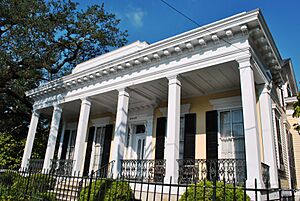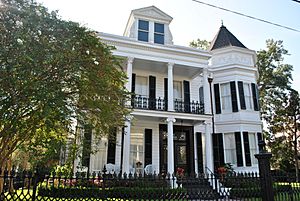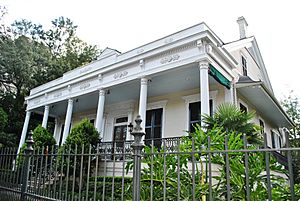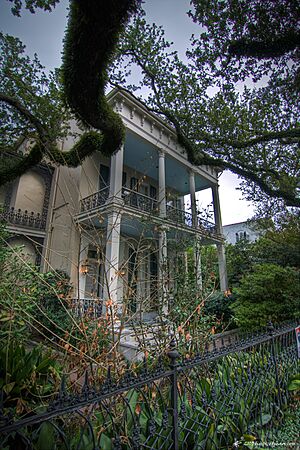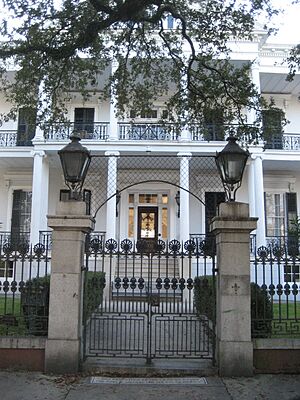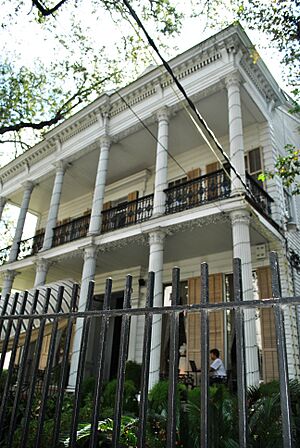Garden District, New Orleans facts for kids
Quick facts for kids
Garden District
|
|
|---|---|
|
New Orleans neighborhood
|
|

Streetcar on St. Charles Avenue in the Garden District with Mardi Gras beads on a tree in the foreground
|
|
| Country | United States |
| State | Louisiana |
| City | New Orleans |
| Planning District | District 2, Central City/Garden District |
| Area | |
| • Total | 0.21 sq mi (0.5 km2) |
| • Land | 0.21 sq mi (0.5 km2) |
| • Water | 0.00 sq mi (0 km2) |
| Elevation | 3 ft (0.9 m) |
| Population
(2010)
|
|
| • Total | 1,179 |
| • Density | 5,610/sq mi (2,170/km2) |
| Time zone | UTC-6 (CST) |
| • Summer (DST) | UTC-5 (CDT) |
| Area code(s) | 504 |
The Garden District is a beautiful neighborhood in New Orleans, Louisiana. It's famous for its amazing old houses and green spaces. This area was first built between 1832 and 1900. It's known for having some of the best-preserved historic mansions in the southern United States.
Wealthy people moved here in the 1800s. They built grand homes because New Orleans was a very rich city back then. The Garden District shows how fancy and important the city was during that time.
Contents
Exploring the Garden District's Location
The Garden District is located at 29°55′40″N 90°05′05″W / 29.92778°N 90.08472°W. It sits about 3 feet (1 meter) above sea level. This neighborhood covers a total area of about 0.21 square miles (0.54 square kilometers). Almost all of this area is land.
Neighboring Areas Around the Garden District
The Garden District is surrounded by several other neighborhoods:
- Central City is to the north.
- Lower Garden District is to the east.
- Irish Channel is to the south.
- Touro is to the west.
Understanding the Garden District's Borders
The City Planning Commission says the Garden District is bordered by these streets: St. Charles Avenue, 1st Street, Magazine Street, and Toledano Street.
However, the Garden District Association has slightly different borders. They include both sides of Carondelet Street, Josephine Street, both sides of Louisiana Avenue, and Magazine Street.
People Living in the Garden District
In 2000, about 1,970 people lived in the Garden District. There were 1,117 households, which means groups of people living together.
By 2010, the number of people living there was 1,926. There were 1,063 households in the neighborhood.
The Rich History of the Garden District
|
Garden District
|
|
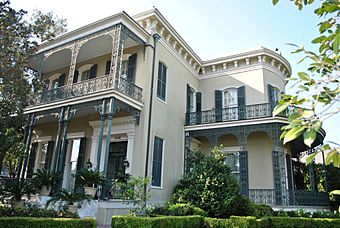
Colonel Short's Villa
|
|
| Lua error in Module:Location_map at line 420: attempt to index field 'wikibase' (a nil value). | |
| Location | Bounded by Carondelet, Josephine, and Magazine Sts., and Louisiana Ave., New Orleans, Louisiana |
|---|---|
| Built | 1835 |
| Architect | Multiple |
| Architectural style | Mid 19th Century Revival, Late Victorian |
| NRHP reference No. | 71000358 |
| Significant dates | |
| Added to NRHP | June 21, 1971 |
| Designated NHLD | May 30, 1974 |
This entire area was once made up of large plantations. One of these was the Livaudais Plantation. Over time, parts of these plantations were sold off.
Wealthy Americans bought these land parcels. They wanted to build homes away from the French Quarter, where many Creole families lived. In 1833, the area became part of the city of Lafayette. Then, in 1852, it became part of New Orleans. A planner named Barthelemy Lafon designed the layout of the district.
How the Garden District Got Its Name
When the area was first developed, each block had only a few houses. These houses were surrounded by very large gardens. This is how the district got its famous name.
Later in the 1800s, some of these big lots were divided into smaller ones. This happened as the area became more like a city. Today, many blocks have a mix of grand 19th-century mansions and houses with fancy "gingerbread" decorations from the late Victorian period. So, the Garden District is now known more for its amazing architecture than for its actual gardens.
In 1974, a slightly larger part of the district was named a National Historic Landmark. This means it's a very important historical place.
Famous Landmarks and Homes in the Garden District
The Garden District is home to many historic buildings and interesting places. Here are some of them:
- Gilmour – Parker House, at 1520 Prytania Street, was built in 1853 for Thomas Corse Gilmour, a cotton merchant. Later, John M. Parker Jr., who became Governor of Louisiana, lived here.
- Bradish Johnson House, at 2341 Prytania Street, was built in 1872. It was designed by James Freret, an architect who studied in Paris. Since 1929, it has been the Louise S. McGehee School for girls.
- Adam-Jones House, at 2423 Prytania Street, was built for John I. Adams, a merchant. It was restored in the 1960s by Mrs. Hamilton Polk Jones.
- Women's Guild of the New Orleans Opera Association, at 2500 Prytania Street, was built in 1859. It was given to the Women's Guild in 1965.
- R.N. Girling's "English Apothecary", at 2726 Prytania Street, was a pharmacy run by Robert Nash Girling in the late 1800s. He was important in making Louisiana the first state to license pharmacists.
- Claiborne Cottage, at 2727 Prytania Street, is a beautiful Greek Revival cottage built in 1857. It was once owned by Sophronie Claiborne Marigny, the daughter of Louisiana's first Governor.
- Penrose-Sere House, at the corner of Prytania and Philip Street, was finished in 1894. It was the first house designed by architect Frank P. Graveley.
- 1134 First Street is where Jefferson Davis, who was the President of the Confederate States, passed away on December 6, 1889.
- Brevard-Rice House, at 1239 First Street, was built in 1857. The famous novelist Anne Rice and her husband, Stan Rice, bought this house in 1989.
- Colonel Short's Villa, at 1448 Fourth Street, is a large old estate with a unique iron fence that looks like cornstalks. It was built in 1859. During the Civil War, it was used by federal forces and even served as the home for Louisiana's governor for a short time.
- The George Washington Cable House, at 1313 8th Street, is another National Historic Landmark.
- The Manse, at 2328 Coliseum Street, was built in 1859. It was later bought by the Prytania Street Presbyterian Church to be the minister's home.
- 2707 Coliseum Street was the childhood home featured in the 2008 movie The Curious Case of Benjamin Button.
- Goldsmith-Godchaux House, at 1122 Jackson Avenue, was designed in 1859. It is special because of its painted interiors, which have more fresco and stenciling than almost any other home from that time in the South.
- Trinity Church Episcopal, at 1329 Jackson Avenue, was founded in 1847. The church building was erected between 1852 and 1854.
- Buckner Mansion, at 1410 Jackson Avenue, is a grand mansion built in 1856. It was featured in the TV show American Horror Story: Coven.
- Lafayette Cemetery No. 1, at 1420 Washington Avenue, was started in 1833. It has many old and important tombs. Many people of German and Irish heritage are buried here.
- St. Mary's Chapel, at 1516 Jackson Avenue, was built in 1844 as a church. It was moved and rebuilt at its current site in 1997.
- Mayor Isaac W. Patton House, at 1527 Washington Avenue, was built around 1859. It was the home of Isaac W. Patton, who was the mayor of New Orleans from 1878 to 1880.
- Commander's Palace, at 1403 Washington Avenue, opened in 1880. It is one of New Orleans' most famous restaurants.
- Squires House, at 2220 St. Charles Avenue, was built in 1851. It was remodeled in 1884. Since 1970, a dress shop called The House of Broel has been located here.
- Alfred Grima House, at 2701 St. Charles Avenue, was built in 1857. It was later owned by Alfred Grima, an attorney, and was extensively remodeled.
- Other important places in the neighborhood include the historic Anshe Sfard synagogue and "The Rink," which was once a skating rink and is now a small shopping center.
How the Garden District Handles Storms
People have known about the risk of flooding in New Orleans since the 1820s. When Hurricane Katrina hit in 2005, the Garden District experienced wind damage. However, because it is on higher ground, it did not flood as much as many other parts of the city.
The wind damage from Katrina was the main effect here. Almost all the residents returned to their homes after the hurricane. Even though some parts of the area near St. Charles Avenue are only four feet above sea level, the Garden District was mostly safe from the flooding caused by Katrina.
Getting Around the Garden District
The New Orleans Regional Transit Authority provides public transportation in the area. The historic streetcar is a popular way to get around and is easily found on St. Charles Avenue. A ride on the streetcar costs $1.25 per person.
Schools in the Garden District
The Garden District is part of the New Orleans Public Schools system.
- Batiste Cultural Arts Academy is a charter school in the area.
- Public high schools nearby include McMain High School and McDonogh 35 High School.
- The McGehee School, a private school for girls, is located within the Garden District.
- Trinity School of New Orleans is also in the area.


